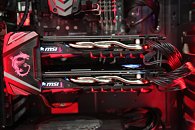- Joined
- Oct 9, 2007
- Messages
- 47,777 (7.41/day)
- Location
- Dublin, Ireland
| System Name | RBMK-1000 |
|---|---|
| Processor | AMD Ryzen 7 5700G |
| Motherboard | Gigabyte B550 AORUS Elite V2 |
| Cooling | DeepCool Gammax L240 V2 |
| Memory | 2x 16GB DDR4-3200 |
| Video Card(s) | Galax RTX 4070 Ti EX |
| Storage | Samsung 990 1TB |
| Display(s) | BenQ 1440p 60 Hz 27-inch |
| Case | Corsair Carbide 100R |
| Audio Device(s) | ASUS SupremeFX S1220A |
| Power Supply | Cooler Master MWE Gold 650W |
| Mouse | ASUS ROG Strix Impact |
| Keyboard | Gamdias Hermes E2 |
| Software | Windows 11 Pro |
Here some of the first pictures of an NVIDIA add-in card (AIC) partner branded SLI-HB (high-bandwidth) bridge. This kind of bridge is recommended for use with GeForce "Pascal" graphics cards, at high resolutions, such as 4K @ 60 Hz with HDR, 4K @ 120 Hz, 5K, and above. Pictured here is a 2-way SLI HB bridge with 2U spacing (1-slot gap between the two cards). The bridge appears to have a red LED of its own, lighting up the MSI Gaming dragon logo. At this point it's not clear whether the bridge comes included with the cards, or if it needs to be purchased separately. The cards being bridged in these pictures are the MSI GeForce GTX 1080 Gaming Z, a notch above the GTX 1080 Gaming X the company debuted its custom GTX 1080 lineup with.


View at TechPowerUp Main Site


View at TechPowerUp Main Site






 ..you good sir are totally correct. Most companies(best buy office depot etc) loose money on selling hardware ....they make up the margin in services, product protection plans etc.(100% profit)and accessories(greater than 40% mark up)...so if a $40 sli bridge is $30 profit...add that to the sale of two graphic cards.... multiply by a couple of million= guys who never where the same socks twice.
..you good sir are totally correct. Most companies(best buy office depot etc) loose money on selling hardware ....they make up the margin in services, product protection plans etc.(100% profit)and accessories(greater than 40% mark up)...so if a $40 sli bridge is $30 profit...add that to the sale of two graphic cards.... multiply by a couple of million= guys who never where the same socks twice.